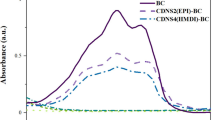Abstract
In our recent work, we have reported on hydrogels devoid of cross-linkers. After observing the successful swelling and water retention properties, we have introduced β-cyclodextrin in acrylamide-co–N-(hydroxymethyl)-acrylamide hydrogel to introduce hydrophobic cores. In this work, we have focussed to improve the sustainable drug release and toxic dye removal performance of hydrogel by introducing β-cyclodextrin (β-CD). Four different grades of β- cyclodextrin grafted acrylamide-co–N-(hydroxymethyl)-acrylamide have been synthesized through free radical polymerization technique at room temperature. Different proportions of β-CD and fixed amount of acrylamide (AM), N-(hydroxymethyl)-acrylamide (NHMA) and 2,2′-azobis-[2-(2-imidazolin-2-yl)-propane] dihydrochloride (AIPD as an initiator) have been used. The synthesized grades were characterized using FTIR, SEM, TGA, UV–visible and powder XRD. Hydrogels have shown high swelling capacity, i.e. 3000 times higher than dry weight. The diffusion studies of drug loaded hydrogels have been performed which have followed quasi-Fickian drug release behavior. Cumulative drug release studies of diclofenac sodium has been investigated in buffer solution at pH 7.4 for 66 h. The toxic cationic dye (methylene blue) removal studies have been carried out in highly concentrated dye contaminated aqueous solution at neutral pH. Hydrogel resulted in complete removal of MB dye with lesser dose and in short span of time. β-Cyclodextrin grafted acrylamide-co–N-(hydroxymethyl)-acrylamide-2 and β-cyclodextrin grafted acrylamide-co–N-(hydroxymethyl)-acrylamide-3 showed highest 77% drug release and almost 100% dye removal from solution, respectively.
Graphic abstract











Similar content being viewed by others
References
Louzri F, Bennour S (2018) Swelling behavior of poly(N-hydroxymethyl-acrylamide-co-acrylic acid) hydrogels and release of potassium nitrate as fertilizer. J Polym Eng 38:437–447
Ahmed EM, Aggor FS, Awad AM, El-Aref AT (2013) An innovative method for preparation of nanometal hydroxide superabsorbent hydrogel. Carbohydr Polym 91:693–698
Buchholz FL, Graham AT (1998) Modern superabsorbent polymer technology. Wiley, New York, pp 1–7
Kapoor S, Kundu SC (2016) Silk protein-based hydrogels: promising advanced materials for biomedical applications. Acta Biomater 31:17–32
Li Y, Huang G, Zhang X, Li B, Chen Y, Lu T, Xu F (2013) Magnetic hydrogels and their potential biomedical applications. Adv Funct Mater 23:660–672
Pourjavadi A, Kurdtabar M, Ghasemzadeh H (2008) Salt-and pH-resisting collagen-based highly porous hydrogel. Polym J 40:94–103
Joglekar M, Trewyn BG (2013) Polymer-based stimuli-responsive nanosystems for biomedical applications. Biotechnol J 8:931–945
Alghamdi AA, Saeed WS, Al-Odayni AB, Alharthi FA, Semlali A, Aouak T (2019) Poly(ethylene-co-vinylalcohol)/poly(δ-valerolactone)/aspirin composite: model for a new drug-carrier system. Polymers 11:439
Hoffman AS (2012) Hydrogels for biomedical applications. Adv Drug Delivery Rev 64:18–23
Peppas NA, Bures P, Leobandung WS, Ichikawa H (2000) Hydrogels in pharmaceutical formulations. Eur J Pharm Biopharm 50:27–46
Gupta P, Vermani K, Garg S (2002) Hydrogels: from controlled release to pH-responsive drug delivery. Drug Discov Today 7:569–579
Anirudhan TS, Tharun AR (2012) Preparation and adsorption properties of a novel interpenetrating polymer network (IPN) containing carboxyl groups for basic dye from aqueous media. Chem Eng J 181:761–769
Baybas D, Ulusoy U (2016) Adsorptive features of polyacrylamide–aluminosilicate composites for methylene blue. Turk J Chem 40:147–162
Üzüm ÖB, Karadağ E (2006) A new sorbent chemically cross-linked highly swollen copolymeric hydrogels for dye uptake. Polym-Plast Technol Eng 45:1277–1283
Fajardo AR, Silva MB, Lopes LC, Piai JF, Rubira AF, Muniz EC (2012) Hydrogel based on an alginate–Ca2+/chondroitin sulfate matrix as a potential colon-specific drug delivery system. RSC Adv 2:11095–11103
García-Astrain C, Avérous L (2019) Synthesis and behavior of click cross-linked alginate hydrogels: effect of cross-linker length and functionality. Int J Biolog Macromol 137:612–619
Perova TS, Vij JK, Xu H (1997) Fourier transform infrared study of poly(2-hydroxyethyl methacrylate) PHEMA. Colloid Polym Sci 275:323–332
Hassani A, Kiransan M, Soltani RDC, Khataee A, Karaca S (2015) Optimization of the adsorption of a textile dye onto nanoclay using a central composite design. Turk J Chem 39:734–749
Chen G, Jiang M (2011) Cyclodextrin-based inclusion complexation bridging supramolecular chemistry and macromolecular self-assembly. Chem Soc Rev 40:2254–2266
Mellet CO, Fernández JMG, Benito JM (2011) Cyclodextrin-based gene delivery systems. Chem Soc Rev 40:1586–1608
Kiran Tiwari R, Krishnamoorthi S, Kumar K (2019) Synthesis of cross-linker devoid novel hydrogels: swelling behaviour and controlled urea release studies. J Environ Chem Eng 7:103162
Liang Y, Zhao X, Ma PX, Guo B, Du Y, Han X (2019) pH-responsive injectable hydrogels with mucosal adhesiveness based on chitosan-grafted-dihydrocaffeic acid and oxidized pullulan for localized drug delivery. J Colloid Interf Sci 536:224–234
Rehan M, Zaghloul S, Mahmoud FA, Montaser AS, Hebeish A (2017) Design of multi-functional cotton gauze with antimicrobial and drug delivery properties. Mater Sci Eng, C 80:29–37
El-Naggar ME, El-Rafie MH, El-Sheikh MA, El-Feky GS, Hebeish A (2015) Synthesis, characterization, release kinetics and toxicity profile of drug-loaded starch nanoparticles. Int J Biol Macromol 81:718–729
Rao KM, Mallikarjuna B, Krishna Rao KSV, Sudhakar K, Rao KC, Subha MCS (2013) Synthesis and characterization of pH sensitive poly(hydroxy ethyl methacrylate-co-acrylamidoglycolic acid) based hydrogels for controlled release studies of 5-fluorouracil. Int J Polym Mater Polym Biomater 62:565–571
Acknowledgement
The authors gratefully acknowledge the financial support from the Science Engineering and Research Board (ECR/2016/000949), New Delhi, Government of India.
Author information
Authors and Affiliations
Corresponding author
Ethics declarations
Conflict of interest
The authors have no conflict of interest.
Electronic supplementary material
Below is the link to the electronic supplementary material.
Rights and permissions
About this article
Cite this article
Kiran, Tiwari, R., Singh, V.K. et al. Synthesis, characterization of β-CD based novel hydrogels with dual objectives of drug release and dye removal. Iran Polym J 29, 615–623 (2020). https://doi.org/10.1007/s13726-020-00826-4
Received:
Accepted:
Published:
Issue Date:
DOI: https://doi.org/10.1007/s13726-020-00826-4




